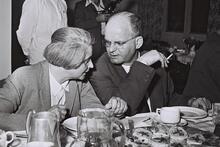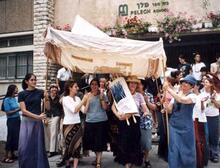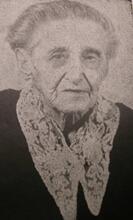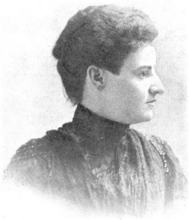Romania, Women and Jewish Education
Modern Jewish education in Romania began in the mid-nineteenth century. For a few decades after the creation of a public school system in Romania, Jews were welcomed into the public schools with an eye towards promoting their assimilation. Subsequently, however, they were expelled from the public schools, leading to the creation of a network of modern Jewish schools, for girls as well as boys. While sexism still limited girls’ opportunities, gradually women’s educational opportunities broadened. With the help of trailblazers in Jewish women’s education, such as Rivka Stem and Mina Cusiner, education became more accessible to Jewish girls in the post-World War I period.
Modernization of Romania
The origins of Romania as a modern-day political entity stem from the unification of the principalities Wallachia and Moldavia in 1859 under the rule of Alexandru Ioan Cuza (1820–1870). In 1862, the parliamentary structures of the two principalities were united and the new government embarked on long-term economic, civic and cultural reforms in an attempt to bridge the cultural gap among the country’s citizens, which stemmed, among other factors, from the high rate of illiteracy.
As part of the modernization measures adopted by the new Romanian regime, two laws were enacted in 1864 that were of significance in terms of internal reform: the first was the agrarian law, which granted 463,544 families ownership over parcels of land totaling 1,810,312 hectares (approximately 4.5 million acres, or 18,200 square km.); the second was the education law, which ensured the establishment of elementary schools and access to free primary education for all children of the state. A by-product of this law was the opening of teachers’ seminaries, vocational schools, and trade schools. In the same period, Romania’s first two universities were founded: The University of Jassy, in 1860, and the University of Bucharest, in 1864. The first constitution of the nascent Romanian state was enacted in 1866, early in the reign of King Carol I. A liberal charter modeled after the Belgian constitution and the Civil Code of France, Romania’s constitution granted numerous freedoms to the majority of the country’s residents (with the exception of the Jews) and civil rights only to taxpayers.
Another important turning point in the development of the Romanian state took place following the Russo-Turkish War of 1877, when the country broke free of its dependence on the Ottoman Empire and declared itself an “independent kingdom” in May of that year. This step accelerated the modernization of the state’s economy and culture: in 1880, the Romanian National Bank was established, and the groundwork was laid for an orderly banking system. A network of railroad tracks was laid throughout the state, boosting the processes of industrialization and urbanization; at the same time, the development of the country’s parliamentary system was sped up. Concurrently with all these developments, social problems—the most serious of which involved the peasants—continued to exist, exploding in the form of an uprising in 1888 and an even more violent one in 1907 which culminated in a full-scale peasants’ revolt that cost many lives.
Jewish Origins in Romania
The Jewish presence in Romania dates back to the fifteenth century, but it reached significant proportions only in the seventeenth century, with the major waves of emigration from eastern and northeastern Europe and, as a result of the Chmielnicki massacres (1648–1649), from Ukraine, Galicia, and Bukovina as well. The Jews played an important role in the modernization of Romania during the eighteenth and nineteenth centuries—in banking and commerce, industrialization (from the mid-nineteenth century as a central influence on the petroleum industry), urbanization (in 1900, eighty percent of Romanian Jewry lived in the major urban centers) and the fostering of education and culture.
Concurrently with these developments, which embraced both the modernization and liberalization of Romanian society and the integration of Jews into Romania’s economy and culture, antisemitic leanings were intensifying not only among the working class—the ordinary residents of the villages and cities—but also, and primarily, among the country’s intellectual elite, which had the broadest and most profound influence on public opinion. These antisemitic trends were also manifesting themselves in the Romanian school system, particularly during the 1880s and 1890s, as will be demonstrated below.
Jewish Education in Romania
Modern Jewish education in Romania developed in several phases. The first stage, which began in 1851 with the founding of the first Jewish public school, in Bucharest, and continued for two decades, was marked by the departure from the traditional Jewish Lit. "room." Old-style Jewish elementary school.heder as the new Jewish elite identified the need for modernization. Typical of this stage were private schools for daughters of the Jewish intellectual elite, referred to also as boarding schools, institutions, or dormitories, which corresponded to the heder for boys. The first of these was founded in Bucharest by Carolina Cohen in 1844; the languages of instruction there, as in all schools of this type established later in Romania, were Romanian, German, and French.
The second stage, from the end of the 1860s to 1893, was characterized by a relative slowdown in the pace of development of the Jewish public-school system, due partly to the opening of the general Romanian schools to Jewish students. In the aforementioned education law of 1864, the legislature did not draw any distinction between Romanians and members of minority groups, including Jews. An amendment to the law, proposed a year later by the Romanian Minister of Education, V. A. Urechia, presented the national goals behind the integration of Jewish children in the general school system: “If Jewish parents send their children to Romanian public schools, the young Jews who will grow up together with Romanians will be more patriotic.” This declaration was part of a string of statements by official government and educational functionaries who called for the inclusion of Jewish children in Romanian education as part of a policy that made the promotion of integration a national priority in the 1860s. The response on the part of the Jews was so favorable that by the 1878/1879 school year, for example, Jewish pupils constituted eleven percent of all Romanian students. By 1883/1884, the proportion of Jewish students had risen to fifteen percent, and even forty to fifty percent in the Moldavia principality. Opposition to this state of affairs from numerous quarters led to a complete about-face in government policy with regard to Jews in the school system—that is, preference for Romanians and expulsion of Jews—to the point where the compulsory education law of 1893 excluded Jewish “non-citizens” from the student population of Romania, to whom this law applied.
Expulsion of Jews from Public Schools
The next stage, beginning in 1893, saw the emergence of a network of modern Jewish schools, with a standardized, up-to-date curriculum. The passage of the primary-education law that year, as stated, marked a turnaround; among other things, the new law limited the number of Jewish pupils in the Romanian school system. The major provisions of the law, made harsher by amendments in 1896, 1900, 1901, 1903, and 1904, emphasized the difference in status between Romanian pupils and teachers, on the one hand, and “foreigners,” on the other: free compulsory education for Romanians only; acceptance to teachers’ seminaries for Romanian students only, and so forth. As expected, the 1893 law caused a drastic decline in the number of Jewish pupils in Romanian schools. It also led naturally to a significant drop in the numbers of female Jewish students, who had until now constituted the majority in most of the public schools for girls. By way of example, in Girls’ Primary School No. 1 in the Nicolina district of Jassy, there were ninety-nine Jewish pupils and forty-nine Christian pupils in the year the law was enacted. As a result of the law, many Jewish children were left without any educational framework; in particular, there was a rise in the number of Jewish girls who were forced to forgo their studies because their parents could not afford to send them to the few Jewish schools that existed. A report sent by the Jewish community of Falticeni to the leadership of the Alliance Israélite Universelle in 1899, for example, notes that 430 Jewish pupils, 330 of them girls, were forced to give up their studies.
The education law, and the difficulties it engendered, led to greater involvement on the part of international Jewish organizations such as the Alliance and the Jewish Colonial Association (JCA). These groups contributed to the development and promotion of Jewish school networks throughout Romania by constructing new schools. By organizing an independent Jewish school system, the Jews were, in effect, reverting to an internal, community-centered pattern; but with the help of intervention by outside organizations, modern Western curricula were formulated in the Jewish school and methods for improved instruction were also gradually implemented.
Expansion of Jewish Schools for Girls
Among the changes that took place as part of the expansion of the Jewish public-school system in Romania following the passage of the education law was the establishment of Jewish schools for girls in a number of cities around the country. In fact, even prior to the 1893 law, such a trend had already begun to emerge, intensifying over the course of the 1890s. In 1891, the Nissim and Lea Halfon School for Girls was established under the auspices of the Sephardic community of Bucharest. Girls’ schools were founded in Bucharest and in Botosani in 1893, in Galati in 1894, and in Jassy in 1898 (the Steaua School and the Reuniunea Femeilor Israelite [Jewish Women’s Association] School). Also in 1898, the Instructiunea elementary school for girls was founded in the Cruce de Piatra quarter of Bucharest, with another girls’ school founded in Focsani the following year. Several dozen more Jewish schools for girls were established throughout the country up until Romania’s entry into World War I.
Despite the opening of such a large number of girls’ schools in so short a time, there were complaints raised in 1901 by Luize Astruc, wife of Israel Astruc (who served as representative of the Alliance and of the JCA in Romania during the early decades of the twentieth century) concerning the shortage of schools for girls: “From my first days in Bucharest, I was astonished by the large number of young women who were denied any opportunity for education.” In his report to the JCA in 1912, Israel Astruc stated that “the most important part of the JCA’s work in Romania is the education of young girls.”
The next major turnaround that stemmed from a recognition of the educational needs of Jewish girls entailed turning the boys’ schools into coeducational settings. Although the phenomenon of mixed schools was becoming more common, this solution was still not seen as optimal, due both to Jewish tradition and to Romanian law, which limited coeducational schools to villages. Indeed, for these reasons, mixed Jewish schools were generally opened only in small communities with scant financial means, such as Sulita, Bucecea, Raducaneni and Frumusica, among others.
The following figures on the rise in the number of Jewish schools in Romania, divided by gender, are taken from Astruc’s 1912 report to the JCA leadership in Paris: In 1900, there were fifty-four Jewish schools in Romania, of which thirty-seven were for boys, fourteen for girls, and three mixed. In 1912, eighty-two schools were operating in Romania: thirty-one for boys, twenty-four for girls and twenty-seven mixed (seven of which had previously been boys’ schools).
Sexism in Educational Opportunities
The delay in opening schools for girls (both general and Jewish) illustrates one of the obvious ways in which the gender balance of power was slanted in favor of the male: women were restricted to the private sphere, excluded from the centers of power and achievement in Romanian society—the fields of finance, politics and the army—that required higher education. Such an approach was especially apparent in traditional, conservative societies such as Romania’s in the eighteenth and nineteenth centuries and until 1950. Indeed, the exclusion of women from the public sphere in Romania is reflected in their omission from both the Romanian and the Romanian-Jewish historical metanarrative. The perception of women in traditional Romanian society as “child-bearers” and “child-rearers” underscores their problematic position in the private-public dichotomy, confronted with the forces of change versus those of preservation. As the processes of social change made their way into the normative systems of Romanian society, the demand arose for a shift in the traditional division between “male-public” and “women-private” that had hitherto held sway in Romanian society (and Eastern Europe as a whole), as a necessary step towards improving the civil and social status of women and enabling them to achieve equal rights before the law (which in fact took place only in the post-war Communist era).
According to the conservative, patriarchal Romanian mentality, and even more so, the traditionalist Romanian Jewish mindset, women were seen until the 1950s as apolitical creatures and thus also as ahistorical. The exclusion of women from the public domain extended to professional spheres of activity, including the teaching profession (in Jewish and general settings alike), until the late nineteenth century. The emergence of Jewish women as leading educational figures and as a driving force on the educational scene was obviously a direct outgrowth of the development of schools for girls within the Jewish educational system in Romania (from the late nineteenth century onward, and especially in the early decades of the twentieth century). Although initially these were members of the Jewish elite—wives of industrialists or bankers—who began working for the Jewish school system on a voluntary basis, this step represented the beginning of women’s penetration into the public sphere. Early volunteers in the field of education included Amaliya Tiktin, wife of the philologist Dr. Heimann Tiktin, and Paulina Gelber, wife of the industrialist Moritz Gelber of Jassy. By contrast, signs were beginning to emerge at this time of a trend towards integrating women intellectuals, still few at this stage, in leading teaching positions and even as principals of girls’ schools; thus, for example, the wife of Rabbi Dr. Moritz Beck served as principal of the Ahvat Zion girls’ school, affiliated with the Templul Coral (Choir Synagogue) in Bucharest.
Broadening of Educational Opportunities for Girls
The proliferation of girls’ schools led to a further development during the early decades of the twentieth century: the opening of vocational schools to women, both Jewish and non-Jewish, as well as the opening of trade schools for Jewish women alone, such as the Rasela si Filip Focsaneanu secondary vocational school for girls, founded by the banker Filip A. Focsaneanu in 1898 during his tenure as leader of the Templul Coral. This Jewish industrialist, who also donated the building for the school, requested that the institution be run in accordance with the West European model and expressed his desire that the principal be a female graduate of an educational institution in France or Germany. It is instructive to trace the professional course of one of the vocational teachers at this school. A Miss Buchman served as sewing instructor to some fifty girls after completing a four-year sewing course at a vocational school in Jassy and higher vocational studies in the profession in Paris.
Additional vocational schools for girls were later established, among them the Baroneasa Clara de Hirsch elementary school for home economics, founded in 1902 in Bucharest, with Mina Cusiner as its principal. Cusiner, a leading figure in the development of Jewish education in Romania, played a role in formulating the pedagogical principles of Jewish vocational education. Among other things, Cusiner introduced gardening into the school curriculum as part of classes in nature study. Another vocational school for Jewish girls, run by Pati Leibovici, was established in 1896 in Botosani by the Or Hadash association.
In 1901 the Lumina association, founded in Galati, established an elementary school for home economics, with R. Shwarz as its principal. Classes, which were free of charge, were offered to roughly 120 Jewish girls from impoverished Jewish families; consequently, the administration limited itself to providing a minimal general education with an emphasis on home economics and sewing. Alongside the vocational schools, lessons in handicrafts and home economics were also introduced into general elementary schools for Jewish girls. The large number of vocational schools for girls attests to a change in the perception of the role of women on the part of the Jewish leadership. Although this course of study indicates that women were still being directed toward auxiliary trades such as home economics or the traditional “feminine” occupations (sewing, cooking, etc.), it nevertheless attests to a recognition of the exodus of women from the bounds of the “private” into the “public” sphere. This awareness penetrated even the inherent conformism of Romanian Jewish society, which was still highly conservative at the time.
A further outcome of the broadening of educational opportunities for Jewish girls was the fact that the doors of higher education were opened to them as well. This was initially true only of the daughters of the Jewish elite, who were sent outside Romania to acquire an academic education, largely due to the limitation on the number of Jews in higher education in Romania under the numerus clausus (quota) regulations. In terms of the countries and educational institutions that they chose, the young women of the Romanian Jewish elite were split between the French and the German spheres of influence. Among the women who stood out for their advancement within the Jewish school system in Romania after acquiring a German-oriented education was Ana Shteinberg, who earned her education in Troppau, Switzerland, and upon her return became one of the leading figures in the development of a network of modern Jewish girls’ schools in Romania.
Trailblazers in Jewish Women's Education
An additional phenomenon that attests to a growing trend toward progress and openness with respect to women in Romanian Jewish society (in particular, the elite) is that of young women being sent to complete their education at the teachers’ seminary of the Alliance network in Paris. Although, according to the registration forms, most of the applicants to the seminary were daughters of teachers or principals, as a rule they were members of the Romanian Jewish elite, who began to escape the bounds of their society and enter the public sphere in the early years of the twentieth century.
Among these “trail-blazers,” one must of course include the young Jewish women who managed to overcome the restrictions of the numerus clausus and acquire an academic education at universities within the boundaries of Romania. The first Jewish women to surmount this obstacle comprise some of the outstanding figures in the Jewish educational system of Romania in the early decades of the twentieth century, one of whom was Rivka Stern, who completed her academic studies in history in the Faculty of Literature and Philosophy at the University of Bucharest in 1901. Upon graduating, she was appointed principal of the Jewish school for girls in Ploesti.
Another major figure is Mina Cusiner (cited earlier), who, following her studies in Romania, was appointed principal of the girls’ school in Moinesti, after which she ran the de Hirsch girls’ school in Bucharest. Cusiner was active in the effort to improve the level of the Jewish school system in Romania. She attempted to address the question of the best “formula” for educating young girls in Romanian Jewish society by, among other things, publishing professional articles in the field of education in the periodical Institutorul Evreu. At the first conference of the General Union of Jewish Teachers, she presented her position that “teachers must have a comprehensive general education, be familiar with child psychology, and, in short, be on the level of a graduate of a teaching seminary.”
Romanian Women During World War I
A wide range of social and attitudinal processes affected the status of Jewish women in the field of education in Romania following World War I. Some related to the perception of what it meant to be citizens of Greater Romania, and of the role of women in general in this context, while others stemmed from the heterogeneous ethnic mix that was among the by-products of the change in the country’s borders and its demographic makeup as a result of the fifty percent increase in Romanian territory compared to 1913. As a result of the peace treaties that marked the end of World War I, Romania gained not only the regions of southern Dobruja from Bulgaria, Transylvania from Hungary, Bukovina from Austro-Hungary and Bessarabia from the Soviet Union, but also an assortment of sizeable minority groups, each with a clear sense of national affiliation: Hungarians, Ukrainians, Bulgarians, Germans, Russians and others. In 1930, Romania’s total population stood at 18,057,000, of whom 12,981,300 were Romanians and the rest minorities: 1,425,000 Magyars (Hungarians); over 745,000 Germans; some 600,000 Ukrainians; over 409,000 Russians; over 366,000 Bulgarians; more than 262,500 Gypsies, and roughly half a million others such as Turks, Greeks, Armenians, Poles, Czechs, Serbs, Croatians, Slovaks and Slovenians. This territorial expansion also brought with it a significant rise in the number of Jews: from some 240,000 in the “Old Kingdom” in 1912, comprising 3.3 percent of the population, to over 720,000 Jews in “Greater Romania” in 1930, representing 4.2 percent of the country’s residents.
This heterogeneity can explain the success of the reactionary, conservative trends as a whole—including extreme nationalism, antisemitism, and chauvinism. As a result of their gender and their religious and ethnic affiliations, Jewish women in the districts suffered a double, and even triple, blow: they were identified not only as members of a different religion but also as “foreigners” belonging to an ethnically, culturally, and linguistically separate group: to the Ukrainian ethnic group in Bessarabia, the Germans and Ukrainians in Bukovina, the Hungarians in Transylvania, and the Bulgarians in Dobruja.
In fact, the activity of women in the public/educational sphere was marked by great heterogeneity at this time, obviously in accordance with individual developments in each new district as well as changes in the field of girls’ education and women’s involvement in the profession, within the “Old Kingdom” (the Regat). Transylvania offers an example of fundamental changes that took place in the field of Jewish education in general, and that of girls in particular. In this region, which was annexed to Romania from Hungary in 1919 under the terms of the San Remo Treaty, the Romanian government ignored the treaty’s provisions regarding minorities and imposed an aggressive policy of “Romanianization” on Transylvania, as on all the new territories, as part of a general hard-line policy on minorities. The Romanian Education Ministry immediately shut down all Hungarian state schools, allowing special schools to operate only under the patronage of religious organizations; in addition, Jewish schools were no longer permitted to use Hungarian as their language of instruction, but were forced to teach in either Romanian or “the Jewish mother tongue, namely, Hebrew or Yiddish.” This requirement, which was eminently reasonable with respect to a Jewish population based on Yiddish or Hebrew culture, such as Bessarabian Jewry, was arbitrary and difficult to implement in the case of the Jews of Transylvania. Concurrently, the Hungarian population lost interest in assimilating the Jewish community in its midst. In the wake of these two developments, it is easy to understand the consolidation of the Zionist movement in this district, and the intensive activity of the Tarbut network, a national association of Jewish schools. Its stated goals were disseminating Hebrew as a living, spoken language and fostering the Jewish national idea; toward these ends, the network operated various educational settings, from kindergartens to schools, libraries and even popular universities. Between the two world wars, the Tarbut network operated thirteen to seventeen kindergartens in Transylvania alone; for this purpose, it established a teachers’ seminary in Cluj in the summer of 1920 for the training of Hebrew-language school- and kindergarten teachers. At the same time, it opened a Hebrew coeducational high school in Cluj, attended by close to seven hundred students. In 1919, the largest Jewish lycée (high school) in Transylvania was opened in Timisoara, incorporating innovations in the field of girls’ education. The school, which had a student body of over seven hundred male and female students, encompassed an academic high school and a vocational school for boys, a gimnazjum (secondary school) for girls and a vocational high school for girls.
Similar examples can be seen in the development of Jewish education (including girls’ education) and the role of women in the Jewish school system in the newly annexed provinces Dobruja, Bessarabia and Bukovina. Each of these regions, which formed part of Romanian territory between the world wars, differed from the others, primarily in the degree of emphasis placed on Hebrew or Yiddish versus the local language, i.e., Bulgarian, Russian or German, but also in the importance attached to the study of Jewish history and tradition; in addition, there was some disparity between them in the percentage of girls engaged in study and the duration of their schooling.
Jewish Women in Education upon the Outbreak of World War II
Coming in the wake of the string of antisemitic laws enacted by the Goga-Cuza regime in 1937–1938 and imposed on all Jewish residents of Romania, the outbreak of World War II was an event of major importance, in particular for the Jewish minority in the newly annexed territories, which passed from Romanian hands in the summer of 1940. Bessarabia and northern Bukovina were transferred to the Soviet Union in June 1940, under secret articles contained in the Ribbentrop-Molotov agreement of August 1939; northern Transylvania passed to Hungarian control, in accordance with the second Vienna Diktat (also known as the Vienna Award) of August 30, 1940. The Jewish residents of the two regions met with different fates. In 1941, the overwhelming majority of Jews in Bessarabia were massacred by the Romanian army, working in collaboration with the German army and Einsatzgruppen. In northern Transylvania, it was not until 1944 that the “Final Solution” program began to be implemented.
Similarly, the nature of Jewish education varied from area to area. The school system, like all other spheres of life, functioned differently for the Jews of southern Transylvania, for example (who remained under Romanian control), as opposed to those of northern Transylvania (which returned to Hungarian hands), and was affected as a whole by the antisemitic legislative measures and the process of ghettoization and extermination in each of the regions. A change of major significance took place in Bessarabia and northern Bukovina as well, with a sweeping (and accelerated) process of Sovietization in all spheres of life and especially in the field of education. One of the first stages in the Sovietization of the Jewish school system was the change in the language of instruction from Hebrew to Yiddish and, later, the reduction in the number of Jewish schools, despite the growth of the number of students. In Bessarabia, for example, only eleven Jewish schools encompassing 6,000 male and female students operated in the 1940/41 school year, as compared to thirty-seven Jewish-Hebrew schools that had existed in 1937/38, with over 4,800 students. This situation, of course, was altered drastically with the Romanian-German “reconquest” of Bessarabia and Bukovina in the summer of 1941 and the start of the waves of deportation of the Jewish population to Transnistria.
An additional change in the wake of the passage of these territories into Soviet hands during the year between the summer of 1940 and the summer of 1941 was the large-scale entry of women, including Jewish women, into the labor market, particularly in the field of education. During the year leading up to the “reconquest” of the territories by the Romanians and their German allies, concurrent with the educational reforms, numerous Jewish women entered schools that had undergone a process of Sovietization. These women, like the rest of the Jewish community, now found themselves in the waves of deportation to Transnistria.
Educational Activity of Women in Transnistria
Improvised Jewish educational settings continued to operate even in some of the ghettos and the larger camps in Transnistria; for the most part, it was Jewish women among the deportees who initiated and administered these frameworks. In most of the camps where schooling of some sort existed, it was generally conducted in orphanages within the camps where the most significant numbers of children and teenagers were concentrated. In the ghetto of Balta, for example, a “women’s committee” saw to the ongoing educational and basic needs of a group of close to 170 children (orphaned of both parents) who were lodged in two orphanages in the ghetto.
A similar program was organized in the ghetto of Shargorod, a city/subdistrict in the Mogilev district where numerous Jews were deported from Bukovina and Dorohoi (for some, Shargorod was merely a transit point in their deportation eastward). In December 1941, a typhus epidemic broke out among the residents of the ghetto, claiming one hundred and fifty lives a day at its peak in February–March 1942. The epidemic orphaned large numbers of children; one hundred and eighty of them (who had lost both parents) were gathered into an orphanage funded by donations from the Centrala Evreilor (Jewish Center) in Bucharest and run by Dr. Rosa Levi, an educator from Suceava. Levi saw to it that the children, aged one to fifteen, received not only basic treatment for their health problems (malnutrition, anemia, infections and overall neglect) but also education and guidance. A team of instructors and caregivers worked at the orphanage, including teachers of Hebrew, gymnastics, sewing, handicrafts, etc., along with an attendant and a nurse who looked after both the permanent residents and some four hundred other children (orphaned of only one parent), who benefited from the institution’s activities.
Similar institutions and initiatives on varying scales operated in other ghettoes throughout Transnistria; in most of them, the programs were carried out by individual women or women’s committees. These activities intensified during 1943–1944 with the receipt of operating permits from the Romanian government and the allocation of funds from Jewish organizations within and outside Romania. They continued until the Soviet “liberation” and the end of the war in Romania in the summer of 1944.
Hebrew
Ancel, Jean, and Theodore Lavi, eds. Romania, 2 vols. In Encyclopedia of Jewish Communities. Jerusalem: 1969, 1980.
Levin, Dov. A Time Set Apart: 1939–1941: Changes in the Lives of Jews in the Regions Annexed to the Soviet Union at the Beginning of World War II. Jerusalem/Tel Aviv: 1989.
Rothman, Libiu. Society as Reflected by Its Education: The Romanian Jewish School. Tel Aviv: 1999.
English
Bucur, Maria. “Between the Mother of the Wounded and the Virgin of Jiu: Romanian Women and the Gender of Heroism during the Great War.” Journal of Women’s History 12/2 (2000): 30–55.
Davis, Natalie. “History’s Two Bodies.” American Historical Review 93 (1988): 1–30.
Harsany, Pasca Doina. “Blue Blood and Ink: Romanian Aristocratic Women Before and After World War I.” Women’s History Review 5/4 (1996): 197–511.
Liczek, Irina. “The Masquerade of Equality: Women and Politics in Romania.” In Research on Russia and Eastern Europe. Vol. 2: Women in Post-Communism. London: Emerald Publishing Limited; 1996, 93–101.
Livezeanu, Irina. Cultural Politics in Greater Romania. Cornell, NY: Cornell University Press; 1995.
Samuelli, Annie. Woman Behind Bars. London: Routledge; 1997.











